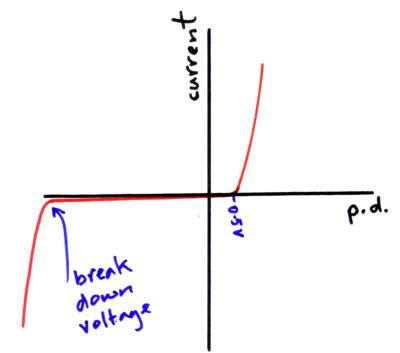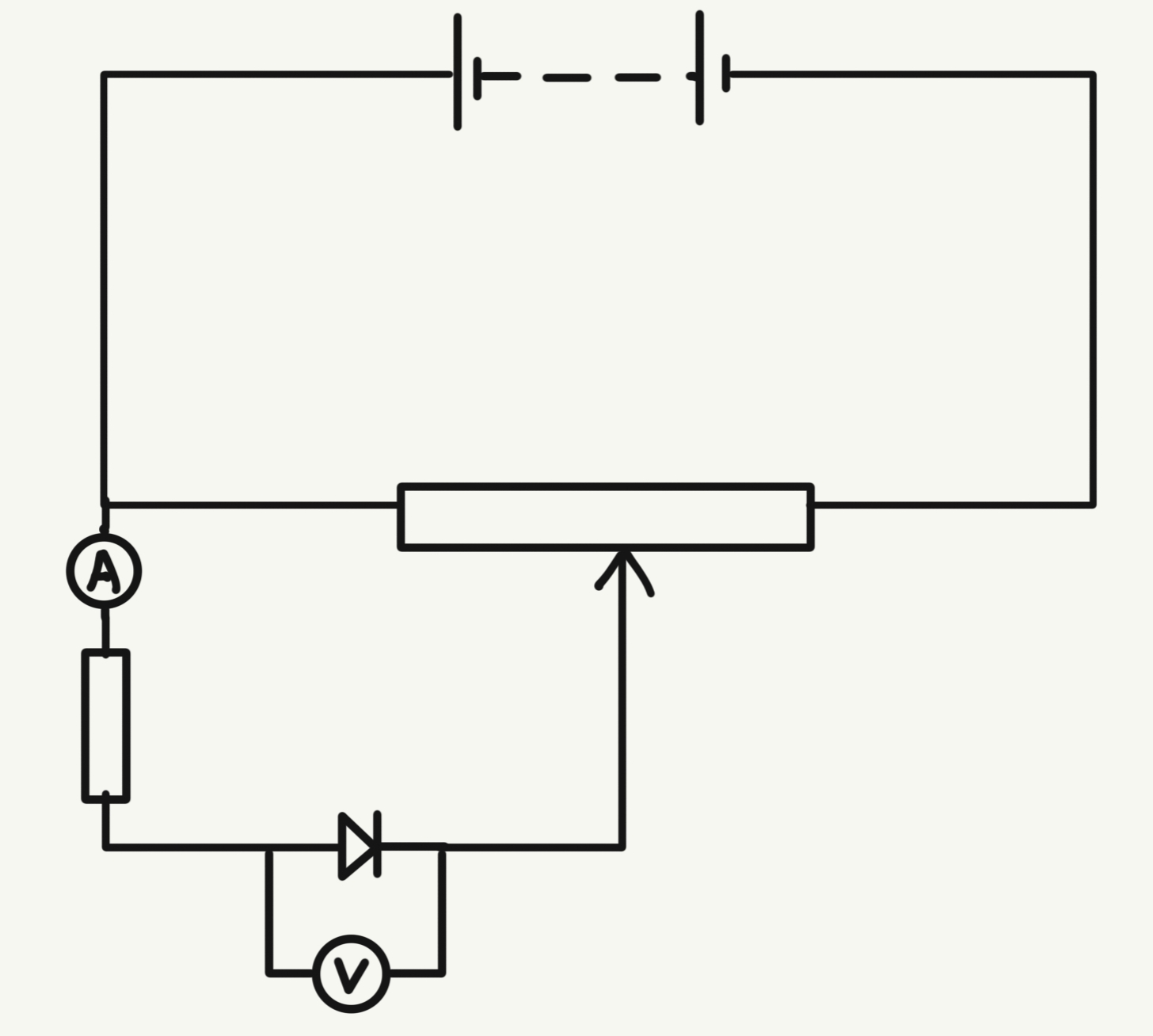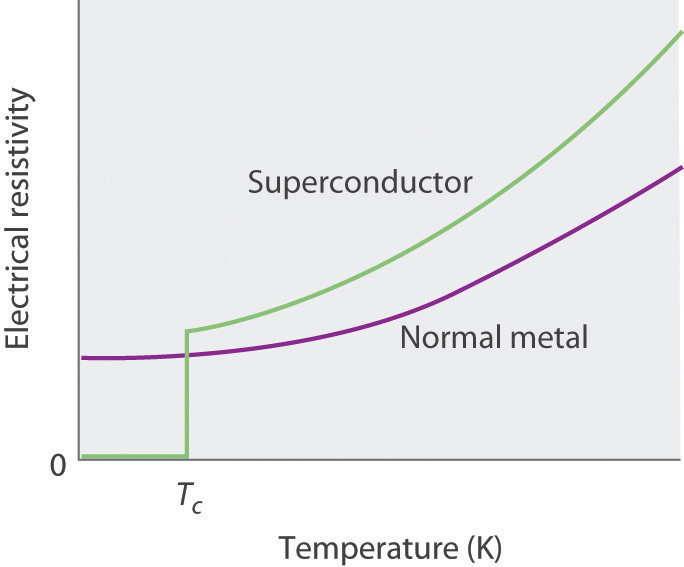
Electricity
Basics
Definitions
current - the rate of flow of charge
electric potential - the amount of energy per unit charge
potential difference - the work done per unit charge (1V = 1C gaining/losing 1J)
electromotive force (emf) - the energy transferred to each unit of charge as it passes through through the source (p.d. across the cell)
resistanceis defined as its equation
Equations
Q = I t
V = W/Q
R = V/I
Current-Voltage Characteristics
At A-level, you need to:
know the shapes of the characteristics for an ohmic component, a filament bulb and a diode (V on horizontal axis and I on vertical and vice versa)
be able to explain why the characteristics for each component are the shape they are
describe an experimental process that will let you collect valid data to obtain the characteristic for a component
Ohmic component
![]()
the potential difference is directly proportional to the current (straight line through origin) - Ohm’s law
this means there is a constant resistance
Filament bulb
![]()
at a low current, the potential difference is directly proportional to the current
as the current increases, the temperature increases causing the ion lattice to vibrate more making it harder for electrons to flow meaning the resistance has increased
for a given p.d., the current is less than for an ohmic conductor
Semiconductor diode

in the forward bias direction, the resistance rapidly decreases after roughly 0.7V
in the negative direction, there is a very high resistance (around 0 current) until voltage breakdown at -50V where there is basically 0 resistance
Potentiometer circuit
Potentiomenter circuits are used to find the characteristics for different components. They must be used in favour of just a variable resistor, as they provide a full range of currents (particularly I = 0A)

when using this circuit to determine the characteristic of a semiconductor diode, a protective (or ballast) resistor must be used to protect the circuit components from too high a current
Resisitivity and Superconductors
Resistivity
resistivity is defined by the equation:
resistivity = resistance x cross-sectional area / length
or ρ = (RA) / L
where resistance is measured in ohms, length is measured in meters and area is measured in metres squared, meaning the unit of resistivity is the ohm meter (Ωm)
Thermistors - UNFINISHED
Superconductors
a superconducting material is one with no resistivity below a critical temperature (often very low)

Uses of superconductors
MRI scans - the weak resistance of superconductors allows very strong currents to flow with no heating in the material, and hence enables to get very high field values
particle accelerators - they can produce very strong magnetic fields (due to high current) and particle accelerators use magnetic fields to accelerate the particles
transformers and generators - they reduce energy dissipation in the transmission of electric power and reduce the fire risk
microchips
Maglev trains
Advantages of superconductors
reduces energy dissipation
high-speed operation
high sensitivity
can generate large magnetic fields
Disadvantages of superconductors
only useful below critical temperature (often requires expensive cryogenic technology)
brittle
expensive
Electricity
Basics
Definitions
current - the rate of flow of charge
electric potential - the amount of energy per unit charge
potential difference - the work done per unit charge (1V = 1C gaining/losing 1J)
electromotive force (emf) - the energy transferred to each unit of charge as it passes through through the source (p.d. across the cell)
resistanceis defined as its equation
Equations
Q = I t
V = W/Q
R = V/I
Current-Voltage Characteristics
At A-level, you need to:
know the shapes of the characteristics for an ohmic component, a filament bulb and a diode (V on horizontal axis and I on vertical and vice versa)
be able to explain why the characteristics for each component are the shape they are
describe an experimental process that will let you collect valid data to obtain the characteristic for a component
Ohmic component
![]()
the potential difference is directly proportional to the current (straight line through origin) - Ohm’s law
this means there is a constant resistance
Filament bulb
![]()
at a low current, the potential difference is directly proportional to the current
as the current increases, the temperature increases causing the ion lattice to vibrate more making it harder for electrons to flow meaning the resistance has increased
for a given p.d., the current is less than for an ohmic conductor
Semiconductor diode

in the forward bias direction, the resistance rapidly decreases after roughly 0.7V
in the negative direction, there is a very high resistance (around 0 current) until voltage breakdown at -50V where there is basically 0 resistance
Potentiometer circuit
Potentiomenter circuits are used to find the characteristics for different components. They must be used in favour of just a variable resistor, as they provide a full range of currents (particularly I = 0A)

when using this circuit to determine the characteristic of a semiconductor diode, a protective (or ballast) resistor must be used to protect the circuit components from too high a current
Resisitivity and Superconductors
Resistivity
resistivity is defined by the equation:
resistivity = resistance x cross-sectional area / length
or ρ = (RA) / L
where resistance is measured in ohms, length is measured in meters and area is measured in metres squared, meaning the unit of resistivity is the ohm meter (Ωm)
Thermistors - UNFINISHED
Superconductors
a superconducting material is one with no resistivity below a critical temperature (often very low)

Uses of superconductors
MRI scans - the weak resistance of superconductors allows very strong currents to flow with no heating in the material, and hence enables to get very high field values
particle accelerators - they can produce very strong magnetic fields (due to high current) and particle accelerators use magnetic fields to accelerate the particles
transformers and generators - they reduce energy dissipation in the transmission of electric power and reduce the fire risk
microchips
Maglev trains
Advantages of superconductors
reduces energy dissipation
high-speed operation
high sensitivity
can generate large magnetic fields
Disadvantages of superconductors
only useful below critical temperature (often requires expensive cryogenic technology)
brittle
expensive
 Knowt
Knowt
